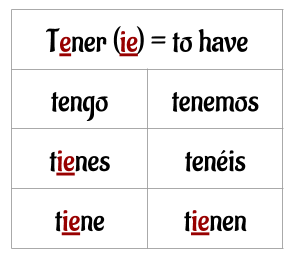Concept of "To BE"
|
SER and ESTAR both mean “To Be”.
When conjugated, they both sound the same in English (I am, you are, he/she/it is, we are, they are). As in all cases, it is important that you first master the FORMS of the verbs before you can master the FUNCTIONS of the two verbs. Below are the conjugation charts for both verbs. After you have mastered the forms (conjugations), you are now able to concentrate on the FUNCTIONS of the two verbs, or when you use each verb.
*You have to memorize the conceptual difference between the two verbs to use them correctly. SER:
|
The first 15 min. 40 seconds address the SER & ESTAR concept. The last 6-10 minutes the SABER & CONOCER concept is addressed.
The adjectives below typically will be associated with the verb SER, as they describe someone physically, their personality, etc.
The adjectives below typically will be associated with the verb ESTAR, as they describe someone's health, emotions or their location.
|
To be... with TenerThere are some ways of describing how one feels that will not use either SER nor ESTAR, but will require the verb TENER because of the nature of the translation in either language.
Example: (Literal translation) Yo tengo hambre. I am hungry. (I have hunger) Él tiene vergüenza. He is ashamed. (He has shame.) Tú tienes miedo. You are afraid. (I have fear.) Ella tiene razón. She is right. (She has reason.) In English we use the verb "to be" in order to tell someone our age, where as in Spanish "to have" is used. Yo tengo 26 años. (I have 26 years.) I am 26 years old. |
One has to understand and remember that when describing how you feel in these regards, you have to use the verb TENER.
|
To be... with WeatherTypically when speaking about the weather, English uses the verb "to be," or "It is..." ("It" referring to Nature), but in Spanish it is translated using the verb hacer, which is translated "to do or make". In essence it is referring to Nature making the weather what it is.
Example: (Literal translation) Hace calor. It is hot. (Nature makes it hot.) Hace viento. It is windy. (Nature makes it windy.) However there are some phrases that require the learner to just memorize them as part of the weather that do not use hace. Ex. Está nublado. It is cloudy. *A simple vocabulary set for weather is found in the Quizlet flashcards. Also note that HAY, is used to refer to "There is" or "There are". Hay sol. It is sunny. (There is sun.) Hay luna. The moon is out. (There is moon.) |
|


